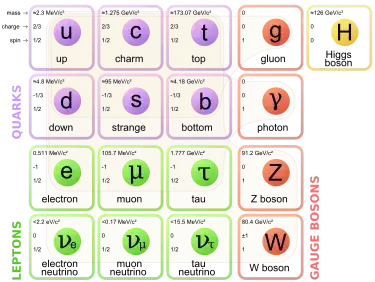Addressing misconceptions
First, I address some misconceptions in your question.
the decay indicates that the muon may be just a composite particle
The fact that the muon decays at all is not evidence that it's composite. It's tempting to say that if a particle $A$ can decay into $B$ and $C$, then it must be "made of" $B$ and $C$. However, this doesn't work out, because almost all particles have multiple decay channels. For example, hydrogen in the $2s$ state can release a photon to go to the $1s$ state, but it can also rarely do this by releasing two photons. As a more extreme example, parapositronium can completely annihilate, turning into two photons, but it can also turn into four.
We think about particle decay in terms of couplings of quantum fields to each other: an excitation in one field can decay into excitations in others. As Feynman put it, those final excitations don't exist "inside" the original one, any more than the word "cat" is bouncing around inside you because you can spend energy to say it.
To that point, seems that electrons may not be fundamental after all: https://www.sciencedaily.com/releases/2016/04/160404111559.htm
This article is about some of the weird ways that large collections of electrons in solids can behave collectively, but it's not related to whether or not electrons themselves are composite. It's important to keep this in mind when reading news releases, because the people who study what electrons in solids do unfortunately tend to give the resulting phenomena the same names as the particles we search for in colliders, leading to a lot of popular confusion.
Answering the question
With that in mind, you're still right, in the sense that it's completely natural to think that the muon might be composite. If you were a scientist in the 1950s, for example, the muon would be just one more particle discovered along with a zoo of mesons and hadrons. Today, we know that all of those mesons and hadrons turned out to be composites of quarks. So why not think of the muon as composite as well?
Indeed, in the early days, the similarity of the muon and electron was taken as possible evidence that the muon was an excited state of the electron, just like the $2s$ state is an excited state of hydrogen. If this were the case, one would expect the muon to often decay by emitting a photon, $\mu \to e \gamma$, but this was found not to be the case. Instead, the decays involving neutrinos dominate.
Now you might ask, why can't the muon be a composite of the electron bound to some neutrinos? This idea doesn't work out because there's no force we know of that would do the job: even in the 1950s it was known that neutrinos interacted extremely weakly. Getting a neutrino to interact with an electron at all is less likely than winning the lottery, so it seems extremely unlikely that it would be simultaneously possible to bind them together.
Another difficulty of any composite muon theory is explaining the muon g-factor, which determines its magnetic moment. Elementary particles are expected to have $g \approx 2$. The composite proton and neutron violate this by a good margin,
$$g_p \approx 5.59, \quad g_n \approx -3.82$$
while the electron and muon have
$$g_e \approx 2.002, \quad g_\mu \approx 2.002.$$
That $0.002$ isn't evidence for compositeness either, because it's precisely what you would expect for a perfectly elementary particle, once you include quantum field theoretic effects. In fact, the electron and muon $g$-factors have been measured to far more decimal places than I've shown, and the results match the Standard Model prediction to great precision. Making the electron and muon composite without upsetting this agreement would seem to require a seriously contrived model, or a miracle.
A meta-difficulty
These already are big difficulties, but if you imagine being a scientist in the 1950s, the quark model had its own problems (such as the complete nonobservability of individual quarks), but it earned support because of its ability to account for huge numbers of hadrons, and predict new ones. And today, people consider theories where the Higgs boson is composite, because it helps give it an appropriate mass.
The meta-difficulty for the muon is that it's only worth trying to make it composite if there's some payoff you expect, such as (1) the completion of a theoretical picture, (2) new predictions, or (3) ways to calculate quantities (such as the muon mass) that we otherwise have to take as inputs.
The first reason doesn't apply, because the muon already has a perfectly good place in the Standard Model: it has to be there because of the family structure of the theory, and this structure is rigid enough that without the muon, the Standard Model would be mathematically inconsistent because of gauge anomalies.
The second reason doesn't apply, either. It's not like we have a series of weird particles lying around that could be explained as further composites of the electron. And since we've measured properties of the muon to exquisite precision, just about any theory of muon compositeness will make "predictions" that we already know to be wrong! You have to work extremely hard just to avoid that. (Admittedly, the muon $g$-factor does seem to deviate a bit from the predicted value, and this does receive attention -- it's just that compositeness isn't the kind of thing that would help here.)
The third reason could potentially apply. However, explaining the masses of particles like the electron and muon is an infamously hard problem, even if you don't take them as composite. Certainly, heads would turn if you came up with a simple theory that gave the muon-electron mass ratio to many decimal places, but decades of failed attempts have made this seem unlikely.
If you just disregarded these reasons, and made a contrived model where the muon was composite, tuning all the constants involved to precisely the values needed to hide all deviations from the Standard Model, then it would "work"... but it would also be scientifically useless.
Of course, it's also completely possible that muons might turn out to be non-elementary, because in science it's impossible to ever prove a negative! At the moment, this possibility is not under active investigation. But it's not heresy either. If sufficiently strange experimental results appeared in the future, scientists could be right back to tinkering with composite electrons and muons, trying their best to understand the results, and the universe.

